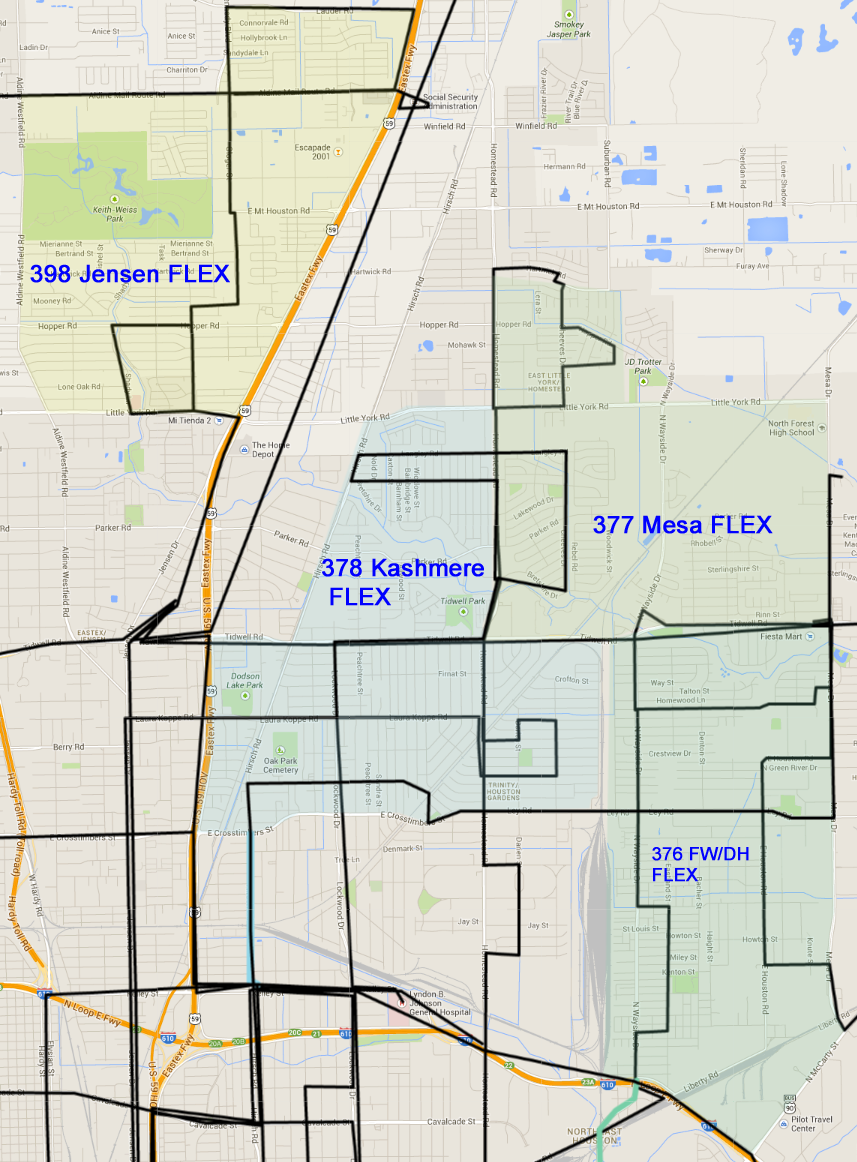As currently proposed, we stand to have five FLEX zones: 395 N. Shepherd FLEX, 398 Jensen FLEX, 377 Mesa FLEX, 378 Kashmere FLEX, and the 376 FW/DH FLEX.
Overlaid with old routes, here are the proposed Northeast Houston FLEX zones...
When I call our current network a Salvador Dali - Jackson Pollack nightmare, this is what I'm talking about. Look at all that duplicate service, twisting, and turning for so little return on ridership!
And now, these four zones overlaid with re-imagined routes... Red lines are fifteen-minute-or-better Frequent Network routes. Blue lines are half-hour frequency. Green are one-hour frequency. Note the hourly route from the 376 FW/DH Flex Zone to the Fifth Ward / Denver Harbor Transit Center. Ditto for the 378 to Kashmere TC... The 377 connects at Mesa TC...at least according to the current online .pdf route details whereas the interactive draft map has the dropoff/connection point at Kashmere TC.
And now, these four zones overlaid with re-imagined routes... Red lines are fifteen-minute-or-better Frequent Network routes. Blue lines are half-hour frequency. Green are one-hour frequency. Note the hourly route from the 376 FW/DH Flex Zone to the Fifth Ward / Denver Harbor Transit Center. Ditto for the 378 to Kashmere TC... The 377 connects at Mesa TC...at least according to the current online .pdf route details whereas the interactive draft map has the dropoff/connection point at Kashmere TC.
And here is the 395 N. Shepherd FLEX...
What I do know is this: if I'm living in these areas and if I can be sure I will be reasonably safe walking, and if it's not two-hundred degrees outdoors, I will walk to and from the one-mile-approximate each was to and from the bus. The lack of a great deal of connectivity to the Frequent Network is a real problem. Clearly, this is a system for seniors in that I can walk to and from my fixed routes far faster than the two-hour call-in-advance requirement all the zones will presumably require, a phone call that will effectively begin my trip right then.
One hates conclusions based on partial information, therefore, I am not dismissing FLEX outright. It will be interesting to see how METRO can alleviate the problems caused with the two-hour call-in-advance time requirement as well as how efficient routings and the driving of these routings can be.
FLEX is a brand-new creature to the Bayou City and our region. It will be fascinating to see how it works out, but for the few people affected by these new FLEX zones, right now it seems riding the bus will be a far-more complex venture than ever before.
May I be proven wrong.






Have you seen pages 9 and 17 in the draft report? They offer some details.
ReplyDeletehttp://transitsystemreimagining.com/web/wp-content/uploads/2014/05/Draft-Network-Plan-Chapter-For-Web.pdf
While you're right that details remain to be worked out, I don't think a two-hour call ahead will be required. The driver's manifest will be made up when the bus prepares to leave the hub, so as long as the request is received by that time it could likely be accommodated.
And while the demand-responsiveness does give people visions of METROLift there are some important distinctions. Many of METROLift's on time performance and reliability issues arise from the fact that it will take a rider anywhere throughout the region. Vehicles making long trips across the city are more likely to be impacted by traffic delays, railroad crossings, etc. The flex routes will remain within relatively small areas in parts of town that don't typically have traffic issues. They will also have at least one time point at the hub, and possibly others at major trip generators, where a rider can board with no advance arrangements.